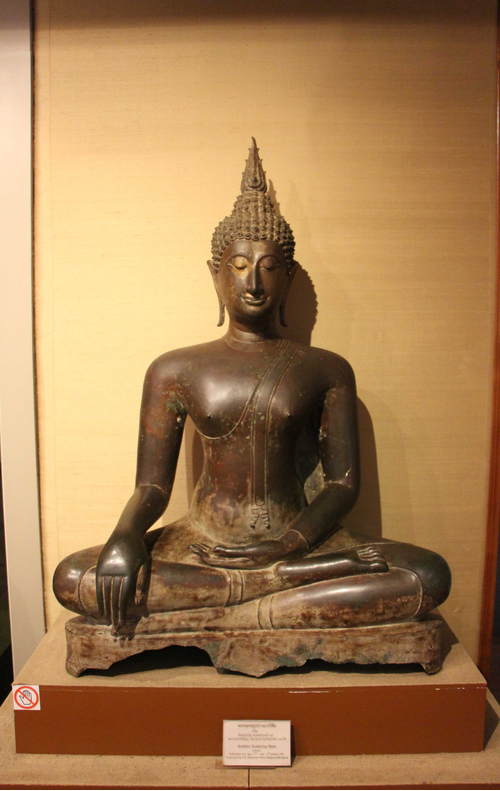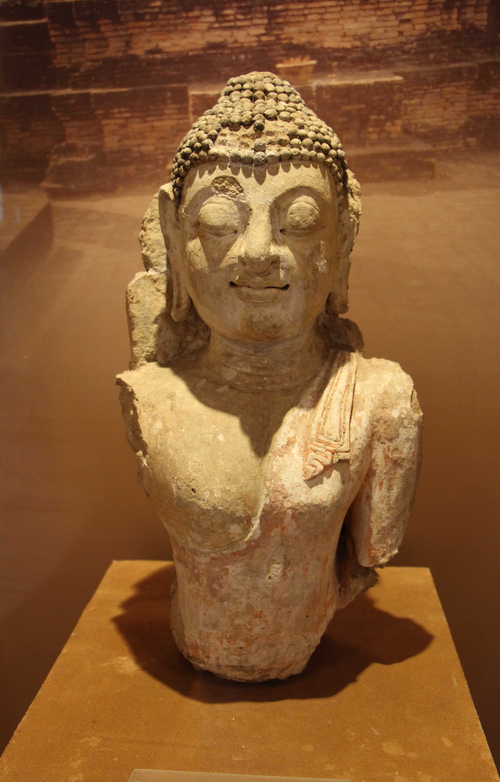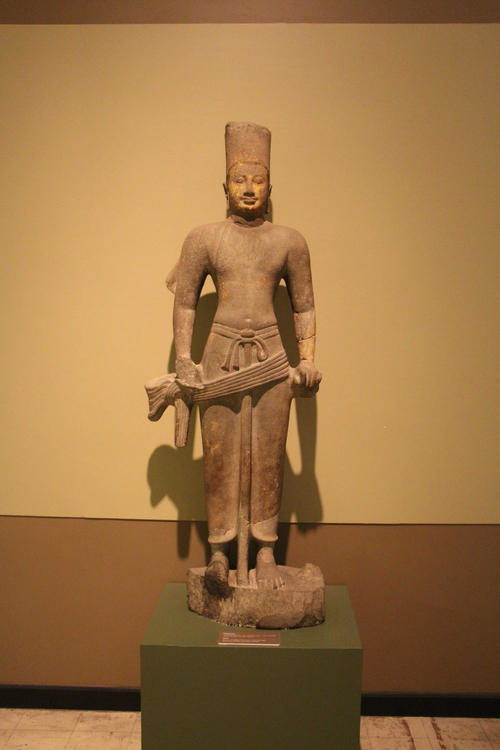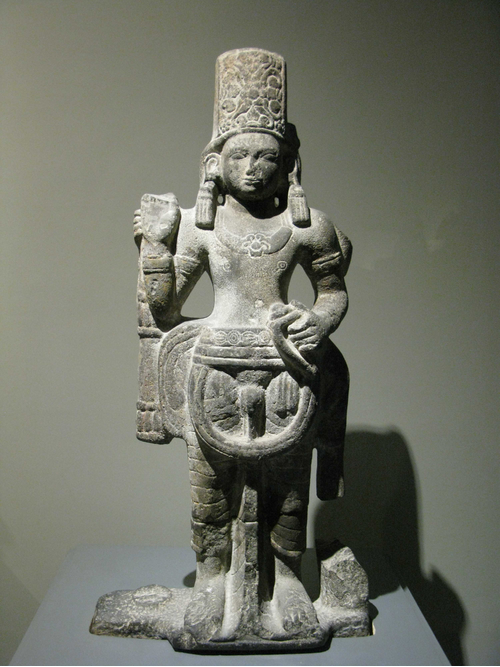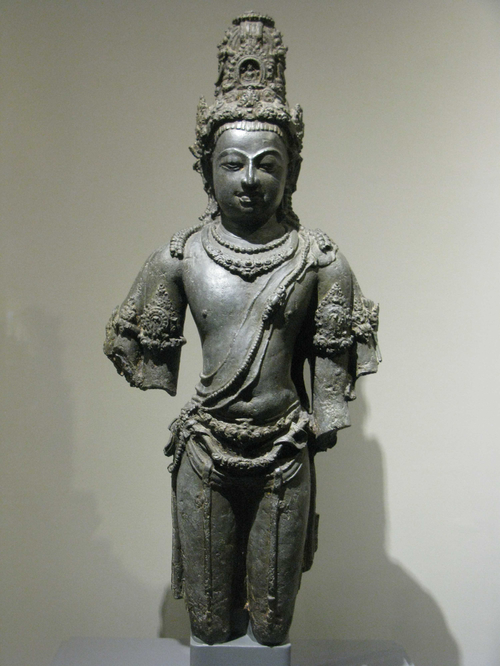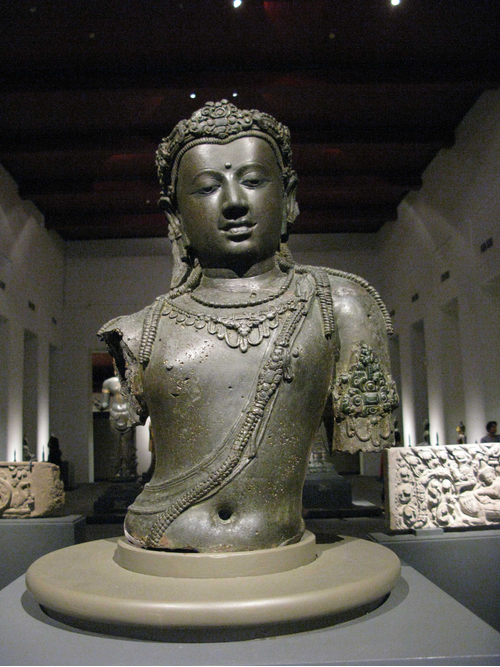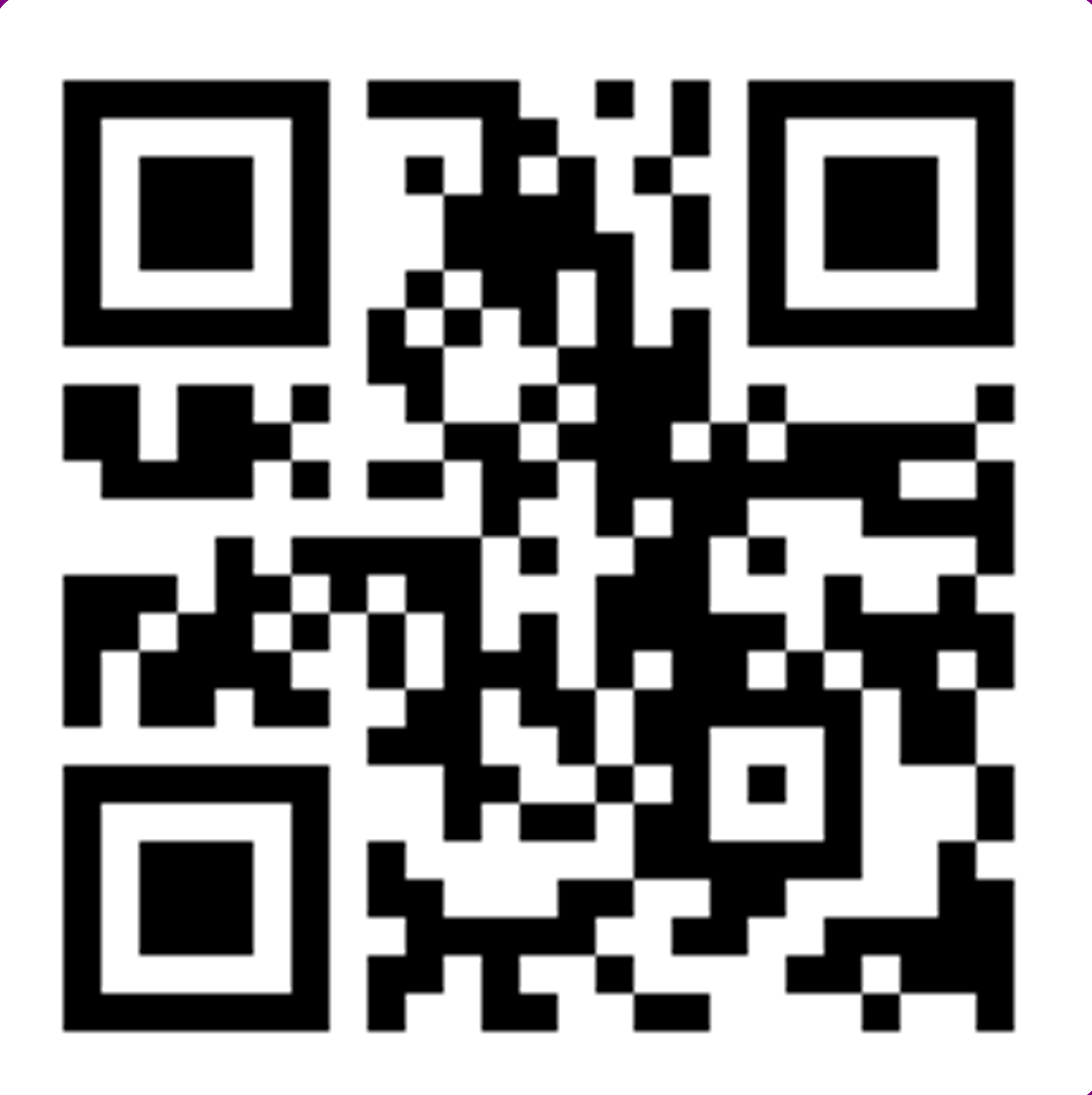ค้นหางานศิลปกรรม
ฐานข้อมูลศิลปกรรมในเอเชียตะวันออกเฉียงใต้
ประติมากรรมพระพุทธรูปปางมารวิชัย
พระพุทธรูปอยู่ในอิริยาบถนั่งขัดสมาธิราบบนฐานหน้ากระดาน พระหัตถ์ทำปางมารวิชัย ลักษณะเด่นซึ่งเป็นแบบแผนของพระพุทธรูปสุโขทัยหมวดใหญ่ ได้แก่ พระพักตร์เป็นวงรูปไข่ พระขนงโก่ง พระเนตรเหลือบต่ำ พระนาสิกโด่งงุ้ม พระโอษฐ์งามสมส่วน เม็ดพะศกใหญ่ขมวดเป็นวงก้นหอย พระอุณีษะนูน พระรัศมีเปลวไฟ ครองจีวรห่มเฉียง เรียบไม่มีริ้ว ชายสังฆาฏิเป็นแถบเล็กและยาวจรดพระนาภี ปลายหยักเป็นริ้วดังที่เรียกว่าเขี้ยวตะขาบ
ประติมากรรมพระพุทธรูป
พระพุทธรูปองค์นี้ชำรุดเสียหายหลายส่วนจนไม่ทราบว่าเดิมทีอยู่ในอิริยาบถใดและทำปางใด ทั้งนี้จากการเป็นประติมากรรมนูนสูงจึงเชื่อว่าน่าจะเคยใช้ประดับศาสนสถานโดยก่ออิงกับผนัง พระพักตร์กลม พระเนตรเหลือบต่ำ พระขนงโก่ง พระนาสิกโด่ง พระโอษฐ์สมส่วนและหยักเป็นคลื่น พระเกศาเป็นเม็ดเล็กๆ พระอุษณีษะนูน พระรัศมีชำรุดสูญหาย พระอุระนูน ครองจีวรห่มเฉียง เรียบไม่มีริ้ว ชายสังฆาฏิเล็กและสั้นเหนือพระถัน มีชายทบซ้อนกันดังที่เรียกกันว่าเขี้ยวตะขาบ
ประติมากรรมพระวิษณุ
พระวิษณุอยู่ในอิริยาบถยืนตรงบนฐานหน้ากระดาน สวมมงกุฎทรงกระบอกหรือกิรีฏมกุฏเกลี้ยง ซึ่งเป็นลักษณะสำคัญที่เห็นได้ชัดของพระวิษณุรุ่นแรกๆ ในดินแดนไทย สัมพันธ์กับพระวิษณุในศิลปะอินเดียแบบปัลลวะพระองค์มี 4 พระกร พระกรขวาหน้าทอดลงจรดพระโสณี (สะโพก) เชื่อว่าเดิมทีเชื่อว่าเคยถือสัญลักษณ์ก้อนดินไว้ในพระหัตถ์ แต่ปัจจุบันชำรุดไปแล้ว พระกรซ้ายหน้าทอดลงจรดพระโสณีและถือตะบองไว้ในพระหัตถ์ แต่ปัจจุบันตะบองชำรุดไปแล้วเหลือแต่เพียงส่วนปลายที่ติดกับฐานหน้ากระดานและโคนที่ติดกับพระหัตถ์ พระกรขวาหลังและพระกรซ้ายหลังหักหายไปหมดแล้ว เมื่อเทียบกับประติมากรรมพระวิษณุอื่นๆ เชื่อว่าทั้ง 2 ข้างยกขึ้น ข้างขวาถือจักร ข้างซ้ายถือสังข์ การถือสิ่งของทั้ง 4 ชนิดในตำแหน่งพระหัตถ์ข้างต้นนี้เป็นแบบแผนของศิลปะอินเดียแบบปัลลวะ พระวรกายช่วงบนเปล่าเปลือย ช่วงล่างสวมผ้านุ่งยาวหรือที่เรียกว่า “โธตี” มีผ้าภูษาคาดพระโสณี (สะโพก) เป็นแนวตรง ประติมากรผู้สลักพระวิษณุองค์นี้คงมีกังวลว่าจะชำรุดแตกหักได้ง่าย พระกรปกติทั้ง 2 ข้างจึงเชื่อมติดกับพระโสณี (สะโพก) และยังใช้จุดรับน้ำหนัก 5 จุด ได้แก่ พระบาท 2 ข้าง แถบหน้านางอยู่ตรงกลาง ชายผ้าภูษาพันรอบพระโสณี (สะโพก) อยู่ทางขวา และตะบองอยู่ทางซ้าย
ประติมากรรมพระวิษณุ
พระวิษณุอยู่ในอิริยาบถยืนตรงบนฐานหน้ากระดาน สวมมงกุฎทรงกระบอกหรือกิรีฏมกุฏเกลี้ยง ซึ่งเป็นลักษณะสำคัญที่เห็นได้ชัดของพระวิษณุรุ่นแรกๆ ในดินแดนไทย ทั้งสัมพันธ์กับพระวิษณุในศิลปะอินเดียแบบปัลลวะพระองค์มี 4 พระกร พระกรขวาหน้าทอดลงจรดผ้าภูษาคาดพระโสณี เชื่อว่าเดิมทีเชื่อว่าเคยถือสัญลักษณ์ก้อนดินไว้ในพระหัตถ์ แต่ปัจจุบันชำรุดไปแล้ว พระกรซ้ายหน้าทอดลงและถือตะบองไว้ในพระหัตถ์ แต่ปัจจุบันตะบองชำรุดไปแล้วเหลือแต่เพียงส่วนปลายที่ติดกับฐานหน้ากระดานและโคนที่ติดกับพระหัตถ์ พระกรขวาหลังและพระกรซ้ายหลังหักหายไปหมดแล้ว เมื่อเทียบกับประติมากรรมพระวิษณุอื่นๆ เชื่อว่าทั้ง 2 ข้างยกขึ้น ข้างขวาถือจักร ข้างซ้ายถือสังข์ การถือสิ่งของทั้ง 4 ชนิดในตำแหน่งพระหัตถ์ข้างต้นนี้เป็นแบบแผนของศิลปะอินเดียแบบปัลลวะ พระวรกายช่วงบนเปล่าเปลือย ช่วงล่างสวมผ้านุ่งยาวหรือที่เรียกว่า “โธตี” มีผ้าภูษาคาดพระโสณี (สะโพก) เป็นแนวเฉียงประติมากรผู้สลักพระวิษณุองค์นี้คงมีกังวลว่าจะชำรุดแตกหักได้ง่าย พระกรปกติข้างหนึ่งจึงยึดติดกับชายผ้าคาดพระโสณี และอีกข้างหนึ่งจึงยึดติดกับตะบองซึ่งเชื่อมต่อกับพระโสณีและฐานอีกทอดหนึ่ง นอกจากนี้แถบหน้านางที่พาดผ่านตรงกลางผ้านุ่งแทนที่จะมีส่วนปลายสิ้นสุดเพียงตำแหน่งชายผ้านุ่ง แต่กลับตั้งใจให้ยาวจรดฐาน ทำให้พระวิษณุองค์นี้มีจุดรับน้ำหนัก 4 จุด ได้แก่ พระบาท 2 ข้าง แถบหน้านาง และตะบอง
ประติมากรรมพระวิษณุ
พระวิษณุองค์นี้อยู่ในอิริยาบถยืนตรง สวมมงกุฎทรงกระบอกหรือกิรีฏมกุฏ ซึ่งเป็นลักษณะสำคัญที่เห็นได้ชัดของพระวิษณุรุ่นแรกๆ ในดินแดนไทยพระองค์มี 4 พระกรตามแบบแผนทางประติมานวิทยาของพระวิษณุ พระกรขวาหน้าแสดงปางประทานอภัย พระหัตถ์ขวาหลังถือตะบอง พระหัตถ์ซ้ายหน้าถือสังข์ในระดับพระโสณี (สะโพก) พระหัตถ์ซ้ายหลังหักหายซึ่งแต่เดิมควรถือจักร ท่าทางและการถือสิ่งของในตำแหน่งข้างต้นนี้มีมาก่อนแล้วในรูปพระวิษณุในศิลปะอินเดียภาคเหนือรุ่นก่อนพุทธศตวรรษที่ 10 พระวรกายช่วงบนเปล่าเปลือย ช่วงล่างสวมผ้านุ่งยาวหรือที่เรียกว่า “โธตี” บางแนบพระวรกายจนเห็นสรีระภายใน มีชายผ้าคาดพระโสณี (สะโพก) รูปวงโค้งพาดผ่านเหนือพระอุรุ (ต้นขา) ลักษณะเช่นนี้เทียบได้กับศิลปะอินเดียภาคใต้ในช่วงก่อนพุทธศตวรรษที่ 10
ประติมากรรมพระพุทธรูปนาคปรก
พระพุทธรูปนาคปรกหล่อจากสำริดองค์นี้สามารถแยกออกจากกันเป็น 3 ส่วน ได้แก่ องค์พระพุทธรูป เศียรนาค และขนดนาคพระพุทธรูปนั่งขัดสมาธิราบพระหัตถ์ทำปางมารวิชัย นับว่าเป็นสิ่งผิดปกติเพราะโดยทั่วไปเมื่อเป็นพระพุทธรูปนาคปรกจะทำปางสมาธิ รูปแบบพิเศษอันเป็นลักษณะของสกุลช่างไชยาซึ่งเห็นในพระพุทธรูปองค์อื่นที่สร้างขึ้นภายหลังด้วย ได้แก่ พระอุษณีษะอยู่ในทรงครึ่งวงกลม เรียบไม่ตกแต่งด้วยขมวดพระเกศา มีแผงสามเหลี่ยมซึ่งเดิมทีคงเคยมีอัญมณีประดับอยู่ทางด้านหน้า ชายสังฆาฏิหรือชายจีวรที่พาดผ่านพระอังสาซ้ายยาวจรดพระนาภีเป็นแถบสี่เหลี่ยมซ้อนทับกันหลายชั้น เศียรนาค 7 เศียรรูปทรงคล้ายสามเหลี่ยมหรือใบโพธิ์ เศียรกลางใหญ่ที่สุด เศียรด้านข้างข้างละ 3 เศียรมีขนาดเล็กกว่าและหันขึ้นสู่เศียรกลาง ทั้งหมดชิดติดกันเป็นแผง เทียบได้กับเศียรนาคปรกในศิลปะลพบุรีหรือเขมรในประเทศไทยสมัยเมืองพระนคร เช่นแบบนครวัดและแบบบายน ขนดนาค 3 ชั้น เทียบได้กับขนดของพระพุทธรูปนาคปรกในศิลปะลพบุรีหรือเขมรในประเทศไทยสมัยเมืองพระนครเช่นกัน โดยเฉพาะอย่างยิ่งในศิลปะแบบนครวัด โดยลักษณะดังกล่าวคือ นาคแต่ละขนดมีขนาดไม่เท่ากัน ขนดบนใหญ่ที่สุดจากนั้นจึงไล่ลำดับลงสู่ขนดล่างที่มีขนาดเล็กที่สุด ทำให้ขนดทั้ง 3 ชั้นเป็นทรงสอบ นอกจากนี้เหนือขนดนาคชั้นบนมีฐานกลีบบัวรองรับพระพุทธรูป
ประติมากรรมพระโพธิสัตว์อวโลกิเตศวร
พระโพธิสัตว์องค์นี้อยู่ในอิริยาบถยืนตรง มีแปดกรแต่ทุกพระกรเหลือเพียงช่วงบนเท่านั้น พระวรกายช่วงล่างตั้งแต่พระชานุลงไปหักหายหมดแล้วเช่นกันพระพักตร์อวบอิ่ม เครื่องประกอบพระพักตร์งามสมส่วน เปลือกพระเนตรปิดลงครึ่งหนึ่ง สวมมงกุฎที่ประดับด้วยกลุ่มเพชรพลอยทรงสามเหลี่ยม มวยพระเกศาทรงกระบอก มีรูปพระพุทธเจ้าอมิตาภะที่อยู่ภายในกรอบวงกลมประดับอยู่กึ่งกลางมวยพระเกศา ปลายพระเกศาเป็นลอนสยายปะพระอังสา สวมเครื่องประดับจำนวนมาก ได้แก่ ยัชโญปวีตที่ทำจากผ้า ยัชโญปวีตนี้ซ้อนทับโดยสังวาลไข่มุกประดับเพชรพลอยอีกชั้นหนึ่ง กรองศอมี 2 เส้น เส้นบนเป็นดั่งเม็ดไข่มุก เส้นล่างเป็นดั่งเครื่องประดับลายเพชรพลอย มีพาหุรัดประดับลายเพชรพลอย ในภาพรวมพระโพธิสัตว์องค์นี้แสดงความเกี่ยวข้องกับศิลปะอินเดียแบบปาละและศิลปะชวาภาคกลางของอินโดนีเซีย อย่างไรก็ตาม งานวิจัยของ รองศาสตราจารย์ ดร.เชษฐ์ ติงสัญชลี ชี้ให้เห็นว่ามีความสัมพันธ์กับศิลปะชวาภาคกลางมากกว่า นอกจากนี้ยังมีสิ่งที่ไม่ปรากฏทั้งในศิลปะปาละและศิลปะชวาภาคกลาง ซึ่งอาจหมายความว่าหล่อขึ้นในภาคใต้ของไทยเอง ได้แก่ ยัชโญปวีตแบบหนังสัตว์ที่ซ้อนทับด้วยสังวาลเพชรพลอย
ประติมากรรมพระโพธิสัตว์อวโลกิเตศวร
ประติมากรรมนี้อยู่ในสภาพชำรุด เหลือเพียงพระเศียรและพระวรกายส่วนบนที่แสดงอาการเอียงตนหรือตริภังค์ ในขณะที่มวยพระเกศา พระกรทั้งสองข้าง และพระวรกายส่วนล่างชำรุดสูญหายไปแล้วพระพักตร์อวบอิ่ม เครื่องประกอบพระพักตร์งามสมส่วน เปลือกพระเนตรปิดลงครึ่งหนึ่ง มีพระอุณาโลมที่พระนลาฏ สวมมงกุฎที่ประดับด้วยกลุ่มเพชรพลอยทรงสามเหลี่ยม มวยพระเกศาที่เคยมีอยู่ทางด้านบนได้หักหายไปแล้ว เหลือแต่พระเกศาเป็นลอนสยายปะพระอังสา สวมเครื่องประดับจำนวนมาก ได้แก่ ยัชโญปวีตแบบหนังสัตว์โดยสังเกตได้จากหัวเลียงผาที่อยู่บริเวณพระอังสาซ้าย ยัชโญปวีตนี้ซ้อนทับโดยสังวาลไข่มุกประดับเพชรพลอยอีกชั้นหนึ่ง กรองศอมี 2 เส้น เส้นบนเป็นดั่งเม็ดไข่มุก เส้นล่างเป็นดั่งเครื่องประดับลายเพชรพลอยที่มีสายอุบะห้อยระย้า มีพาหุรัดประดับลายเพชรพลอย ในภาพรวมพระโพธิสัตว์องค์นี้แสดงความเกี่ยวข้องกับศิลปะอินเดียแบบปาละและศิลปะชวาภาคกลางของอินโดนีเซีย อย่างไรก็ตาม งานวิจัยของ รองศาสตราจารย์ ดร.เชษฐ์ ติงสัญชลี ชี้ให้เห็นถึงรายละเอียดที่ไม่ปรากฏทั้งในศิลปะปาละและศิลปะชวาภาคกลาง ซึ่งอาจหมายความว่าหล่อขึ้นในภาคใต้ของไทยเอง ได้แก่ ยัชโญปวีตแบบหนังสัตว์ที่ซ้อนทับด้วยสังวาลเพชรพลอย
